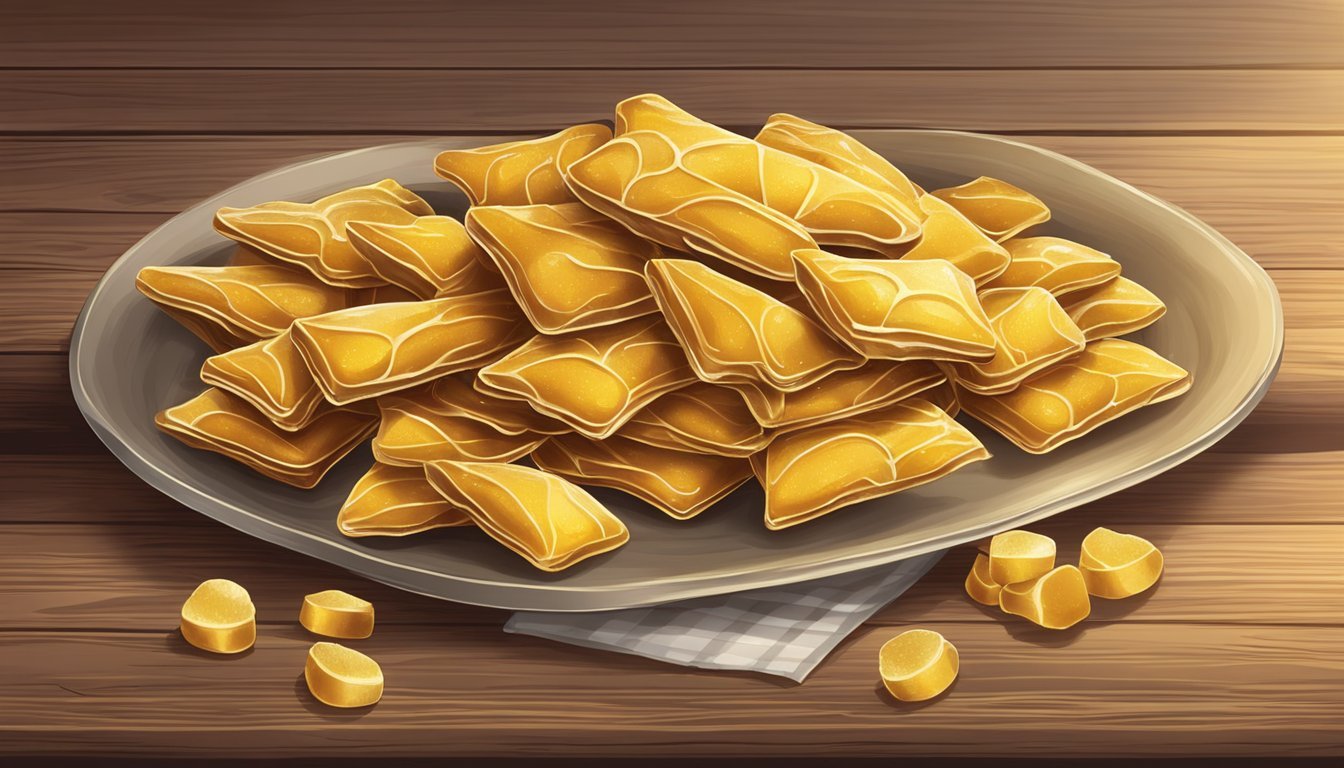Ginger Peel Candy
A Spicy, Chewy Treat Unveiled
Ginger peel candy emerges as an enticing confection that skillfully balances the natural zing of ginger with the delightful chewiness of a traditional treat. With the robust spiciness imbued in every morsel, this candy appeals not only to those seeking the therapeutic benefits of ginger but also to sweet tooth enthusiasts. Renowned for its vibrant flavor and purported health advantages, ginger has found its way from the spice rack to the candy jar, resulting in a treat that provides both a kick of spice and a satisfying texture.
The process of making ginger peel candy involves selecting the freshest ginger, peeling (optionally, as some prefer the additional intensity the peel provides), and then simmering the ginger to tenderize it before finally coating it in sugar. The result is a glossy, crystal-like finish with a chewy center, encapsulating the essence of ginger in a candied form. As a versatile treat, it can serve many roles: a palate cleanser after a meal, a soothing throat lozenge, or simply an invigorating snack throughout the day.
While the origins of this confection are steeped in tradition, today's ginger peel candy combines the wisdom of old methods with modern culinary approaches to cater to contemporary palates. In doing so, it maintains its status as a snack of choice for anyone craving a bold flavor profile wrapped in a tender candy. Fans of ginger peel candy appreciate it for more than its taste; they also recognize it as a testament to the enduring appeal of ginger as a cornerstone ingredient in diverse culinary applications.
The Origin of Ginger Peel Candy
Ginger, known for its sharp spiciness and distinct warmth, has been cherished across many cultures for centuries. Its use not only encompassed culinary applications but also traditional medicine. The journey of ginger from its native Southeast Asia saw it becoming a celebrated spice by ancient civilizations, cherished for both its flavor and purported health benefits.
Historical records suggest that by the Middle Ages, ginger had become a staple element in the spice trade, reaching Europe and the Middle East. This is where ginger began to take on a new, sweetened identity. The art of candy making often involved coating fruits and spices in sugar, a preservation method that also offered a pleasant confectionery.
The birth of ginger peel candy is believed to evolve from earlier methods of sweetening ginger. The trade routes facilitated the spread of this knowledge, eventually leading to innovations in candying methods. Confectioners would first peel and then boil ginger in a sugar syrup until it reached a candied state, imparting a balance between the natural spicy flavor of the ginger and the addictive sweetness of the sugar.
Key Elements of Ginger Peel Candy's History:
Origin: Southeast Asia
Use: Culinary and medicinal
Spread: Via ancient trade routes
Transformation: From traditional spice to candied delicacy
Method: Coating ginger peels in sugar syrup
While the exact origin of ginger peel candy is not precisely documented, its creation undeniably marks the point where the pungent spice took on a confectionery persona, beloved as a sweet and spicy treat that has endured through ages. With this process, the spicy ginger transformed into a chewy and crystallized form, embodying a mélange of intense flavors and textures, celebrated as a traditional candy worldwide.
Health Benefits of Ginger Candy
Ginger candy combines the potent properties of ginger with a palatable sweetness. It is particularly known for aiding digestion and acting as a natural remedy for nausea.
Digestive Aid
Ginger contains gingerol, a compound that promotes the movement of food through the gastrointestinal tract. This can lead to more efficient digestion. Therefore, ginger candy can serve as a digestive aid by leveraging this property, helping to prevent food from lingering in the gut for too long.
Natural Remedy for Nausea
The consumption of ginger has been traditionally associated with alleviating various forms of nausea, including morning sickness. Ginger candy, specifically, can offer a convenient and natural remedy for nausea due to the presence of gingerol, which has anti-inflammatory and antioxidant properties.
Culinary Uses
Ginger peel candy, with its spicy and chewy characteristics, makes an exciting addition to various culinary creations. Its bold flavor complements both sweets and beverages, providing an unexpected twist to traditional treats.
In Traditional Desserts
In this realm, ginger peel candy shines as a versatile ingredient. Chefs incorporate it into holiday gingerbread, lending a piquant bite to the otherwise sweet treat. It also finds a place in Asian desserts, such as gingerbread cake, where it adds a layer of texture and spice.
Gingerbread cake: enhances the cake with its chewy texture and warm spice
Christmas cookies: diced ginger peel candy can be sprinkled on top for a festive twist
As a Flavor Enhancer for Beverages
When it comes to beverages, ginger peel candy can be used to infuse flavors in both alcoholic and non-alcoholic drinks. A ginger candy-studded stir stick will not only sweeten a cocktail but also impart a zesty ginger kick.
Cocktails: a piece of ginger peel candy as garnish adds a spicy note
Mocktails: muddled ginger candy provides depth without the alcohol
In hot drinks, ginger peel candy dissolves slowly, releasing its distinctive heat and sweetness into teas and coffees, thus enriching the drinker's experience.
Hot tea: a few pieces of ginger peel candy can deepen the flavor profile
Coffee: a small amount of ginger peel may be added for those who appreciate a spicy-sweet undertone
Homemade Ginger Peel Candy Recipe
The allure of homemade ginger peel candy lies in its balance of spice and sweetness, coupled with a satisfying chewiness. To achieve this delightful treat, one must focus on high-quality ingredients and precise preparation.
Selecting Quality Ingredients
Ginger Root: Freshness is paramount; choose firm, plump roots with a smooth peel.
Sugar: Use granulated sugar for coating to add crunch.
Water: Essential for boiling and creating the right consistency.
When selecting ginger root for the candy, one should opt for organic roots if available, ensuring no unwanted chemicals interfere with the flavor. The amount of sugar and water used will vary depending on the desired quantity, but a 1:1 sugar-to-water ratio for the syrup is a common benchmark.
Step-by-Step Preparation
Peel the Ginger: Wash and peel the ginger root; slice into thin strips for a chewier candy or smaller pieces for a quick bite.
Boil the Ginger: Place ginger strips in a saucepan with enough water to cover them. Boil until they soften, which usually takes around 20 minutes.
Create Syrup: Drain the ginger, reserving some of the water, and return it to the pan with equal parts sugar; simmer until the sugar dissolves forming a syrup.
Simmer: Continue to simmer the mixture, allowing the ginger to absorb the syrup. Stir occasionally to prevent burning.
One should simmer the ginger and syrup mixture until a majority of the syrup has been absorbed and the mixture starts to dry out slightly, achieving the beginnings of a sticky coating on the ginger slices.
Testing for the Perfect Texture
Test the Consistency: The ginger should be sticky yet firm before drying out.
The Bend Test: Cool a piece and bend it; it should be chewy, not brittle.
Dry FInishing: Once the desired texture is achieved, lay the pieces on a wire rack for several hours to dry out to a chewy consistency before storage.
The key to perfect texture is careful monitoring during the simmering and cooling process. Ginger candy should not be too moist, which can lead to spoiling, or too dry, which would result in a tough texture.
By adhering to the steps outlined above, one can create homemade ginger peel candy that is both spicy and sweet with a wonderfully chewy texture.
Important Cooking Tips
When crafting ginger peel candy, the devil is truly in the details. From precise syrup consistency to proper storage, these tips are pivotal for ensuring your spicy, chewy treat is a success.
Achieving the Optimal Consistency
To ensure the sugar syrup that coats the ginger achieves the optimal consistency, one should simmer it over medium heat. It is essential that the syrup reaches the stage where it is thick enough to cling to the ginger yet fluid enough to allow excess to drip off. This typically involves simmering until the syrup reduces by half, allowing the flavors to concentrate and the syrup to reach an appropriate viscosity.
Storage and Preservation
Proper storage of ginger candy is key to maintaining its quality. The candies should be placed in an airtight container to minimize exposure to moisture and air. For extended shelf life, one can include oxygen absorbers within the container, as they will remove any residual oxygen and prevent the degradation of the candy's texture and flavor. It's best not to refrigerate the candy, as the humidity can affect the sugar's texture, causing it to clump or crystallize.
Frequently Asked Questions
In this section, readers will find important considerations and useful advice for making Ginger Peel Candy, a delightful chewy treat packed with spice and flavor.
Addressing Common Concerns
Are additives and preservatives necessary in making Ginger Peel Candy?
They are not. Ginger Peel Candy is typically made with natural ingredients like ginger, water, and sugar. Homemade versions do not require additives or preservatives, which makes them a healthier choice.
Can vanilla extract be used in Ginger Peel Candy?
Yes, vanilla extract can be added to enhance the candy's flavor profile. Usually, just a teaspoon of pure vanilla extract is stirred into the sugar syrup. However, it's optional and based on personal preference.
Tips for First-Timers
Preparing the Ginger:
Peel the ginger root before slicing to ensure no rough textures are present in the final product.
Thin, uniform slices are recommended for consistency in cooking and texture.
Cooking the Candy:
Monitor the heat: Too high, and the sugar may burn; too low, and the ginger won't crystallize properly.
Patience is crucial. Allow the ginger to simmer and crystallize at its own pace for the best results.
Storing the Candy:
Once the candy has cooled, store it in an airtight container to maintain freshness.
Place it in a cool, dry place away from direct sunlight.
Nutritional Information
Ginger peel candy provides a unique flavor experience, but it's important to consider its nutritional profile, especially regarding its calorie and sugar content.
Caloric and Sugar Content
Each serving of ginger peel candy typically contains a significant amount of sugar, which contributes to its calorie content. A standard serving can have around 11 grams of sugar and a calorie count that often amounts to roughly 45-60 calories per piece, depending upon the recipe and size of the candy. Most of the calories in ginger candy come from carbohydrates in the form of added sugars.
Dietary Considerations
When it comes to dietary considerations, ginger peel candy is naturally gluten-free, as it does not contain wheat or other gluten-containing ingredients. For individuals seeking vegan options, it's important to verify that no animal-derived products like honey are used. A typical nutritional breakdown per serving may look like the following:
Total Fat: 0g
Saturated Fat: 0g
Fiber: 0g
Protein: 0g
Sodium: Minimal, often less than 5mg
It's also important to note that ginger candy often does not contain significant amounts of protein, fat, or dietary fiber. This treat should be consumed in moderation due to its high added sugar content, and those with dietary restrictions should always read labels to ensure compatibility with their requirements.








